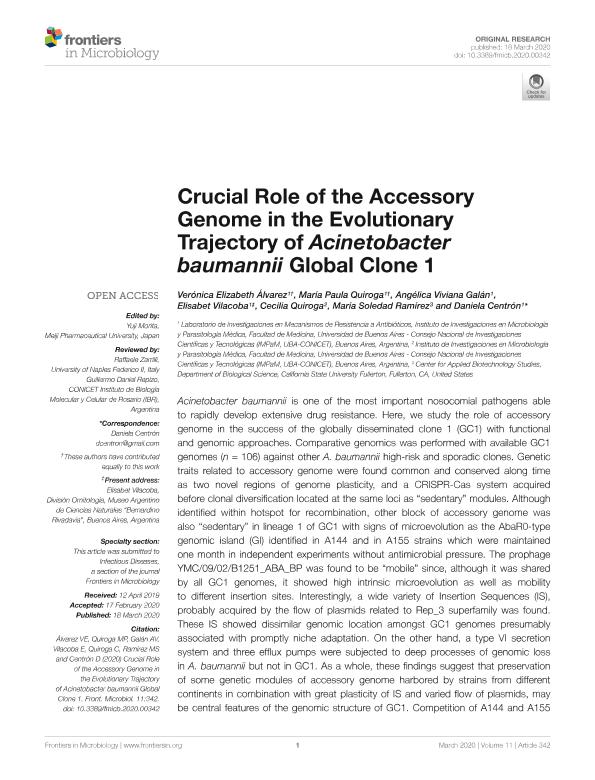Mostrar el registro sencillo del ítem
dc.contributor.author
Alvarez, Verónica Elizabeth

dc.contributor.author
Quiroga, María Paula

dc.contributor.author
Galán Delgado, Angélica Viviana

dc.contributor.author
Vilacoba, Elisabet

dc.contributor.author
Quiroga, Cecilia

dc.contributor.author
Ramírez, María Soledad
dc.contributor.author
Centron, Daniela

dc.date.available
2021-10-14T14:59:20Z
dc.date.issued
2020-03
dc.identifier.citation
Alvarez, Verónica Elizabeth; Quiroga, María Paula; Galán Delgado, Angélica Viviana; Vilacoba, Elisabet; Quiroga, Cecilia; et al.; Crucial role of the accessory genome in the evolutionary trajectory of Acinetobacter baumannii International Clone 1; Frontiers Media; Frontiers in Microbiology; 11; 3-2020; 1-23
dc.identifier.issn
1664-302X
dc.identifier.uri
http://hdl.handle.net/11336/143578
dc.description.abstract
Acinetobacter baumannii is one of the most important nosocomial pathogens able to rapidly develop extensive drug resistance. Here, we study the role of accessory genome in the success of the globally disseminated clone 1 (GC1) with functional and genomic approaches. Comparative genomics was performed with available GC1 genomes (n = 106) against other A. baumannii high-risk and sporadic clones. Genetic traits related to accessory genome were found common and conserved along time as two novel regions of genome plasticity, and a CRISPR-Cas system acquired before clonal diversification located at the same loci as “sedentary” modules. Although identified within hotspot for recombination, other block of accessory genome was also “sedentary” in lineage 1 of GC1 with signs of microevolution as the AbaR0-type genomic island (GI) identified in A144 and in A155 strains which were maintained one month in independent experiments without antimicrobial pressure. The prophage YMC/09/02/B1251_ABA_BP was found to be “mobile” since, although it was shared by all GC1 genomes, it showed high intrinsic microevolution as well as mobility to different insertion sites. Interestingly, a wide variety of Insertion Sequences (IS), probably acquired by the flow of plasmids related to Rep_3 superfamily was found. These IS showed dissimilar genomic location amongst GC1 genomes presumably associated with promptly niche adaptation. On the other hand, a type VI secretion system and three efflux pumps were subjected to deep processes of genomic loss in A. baumannii but not in GC1. As a whole, these findings suggest that preservation of some genetic modules of accessory genome harbored by strains from different continents in combination with great plasticity of IS and varied flow of plasmids, may be central features of the genomic structure of GC1. Competition of A144 and A155 versus A118 (ST 404/ND) without antimicrobial pressure suggested a higher ability of GC1 to grow over a clone with sporadic behavior which explains, from an ecological perspective, the global achievement of this successful pandemic clone in the hospital habitat. Together, these data suggest an essential role of still unknown properties of “mobile” and “sedentary” accessory genome that is preserved over time under different antibiotic or stress conditions.
dc.format
application/pdf
dc.language.iso
eng
dc.publisher
Frontiers Media

dc.rights
info:eu-repo/semantics/openAccess
dc.rights.uri
https://creativecommons.org/licenses/by-nc-sa/2.5/ar/
dc.subject
A. BAUMANNII
dc.subject
ACCESSORY GENOME
dc.subject
GENOMIC PLASTICITY
dc.subject
HIGH-RISK CLONE
dc.subject
INTERNATIONAL CLONE 1 (GC1)
dc.subject.classification
Biología Celular, Microbiología

dc.subject.classification
Ciencias Biológicas

dc.subject.classification
CIENCIAS NATURALES Y EXACTAS

dc.subject.classification
Ciencias de la Información y Bioinformática

dc.subject.classification
Ciencias de la Computación e Información

dc.subject.classification
CIENCIAS NATURALES Y EXACTAS

dc.title
Crucial role of the accessory genome in the evolutionary trajectory of Acinetobacter baumannii International Clone 1
dc.type
info:eu-repo/semantics/article
dc.type
info:ar-repo/semantics/artículo
dc.type
info:eu-repo/semantics/publishedVersion
dc.date.updated
2021-09-07T18:05:54Z
dc.journal.volume
11
dc.journal.pagination
1-23
dc.journal.pais
Suiza

dc.journal.ciudad
Lausanne
dc.description.fil
Fil: Alvarez, Verónica Elizabeth. Consejo Nacional de Investigaciones Científicas y Técnicas. Oficina de Coordinación Administrativa Houssay. Instituto de Investigaciones en Microbiología y Parasitología Médica. Universidad de Buenos Aires. Facultad de Medicina. Instituto de Investigaciones en Microbiología y Parasitología Médica; Argentina
dc.description.fil
Fil: Quiroga, María Paula. Consejo Nacional de Investigaciones Científicas y Técnicas. Oficina de Coordinación Administrativa Houssay. Instituto de Investigaciones en Microbiología y Parasitología Médica. Universidad de Buenos Aires. Facultad de Medicina. Instituto de Investigaciones en Microbiología y Parasitología Médica; Argentina
dc.description.fil
Fil: Galán Delgado, Angélica Viviana. Consejo Nacional de Investigaciones Científicas y Técnicas. Oficina de Coordinación Administrativa Houssay. Instituto de Investigaciones en Microbiología y Parasitología Médica. Universidad de Buenos Aires. Facultad de Medicina. Instituto de Investigaciones en Microbiología y Parasitología Médica; Argentina
dc.description.fil
Fil: Vilacoba, Elisabet. Consejo Nacional de Investigaciones Científicas y Técnicas. Oficina de Coordinación Administrativa Houssay. Instituto de Investigaciones en Microbiología y Parasitología Médica. Universidad de Buenos Aires. Facultad de Medicina. Instituto de Investigaciones en Microbiología y Parasitología Médica; Argentina
dc.description.fil
Fil: Quiroga, Cecilia. Consejo Nacional de Investigaciones Científicas y Técnicas. Oficina de Coordinación Administrativa Houssay. Instituto de Investigaciones en Microbiología y Parasitología Médica. Universidad de Buenos Aires. Facultad de Medicina. Instituto de Investigaciones en Microbiología y Parasitología Médica; Argentina
dc.description.fil
Fil: Ramírez, María Soledad. California State University Fullerton; Estados Unidos
dc.description.fil
Fil: Centron, Daniela. Consejo Nacional de Investigaciones Científicas y Técnicas. Oficina de Coordinación Administrativa Houssay. Instituto de Investigaciones en Microbiología y Parasitología Médica. Universidad de Buenos Aires. Facultad de Medicina. Instituto de Investigaciones en Microbiología y Parasitología Médica; Argentina
dc.journal.title
Frontiers in Microbiology
dc.relation.alternativeid
info:eu-repo/semantics/altIdentifier/doi/https://doi.org/10.3389/fmicb.2020.00342
dc.relation.alternativeid
info:eu-repo/semantics/altIdentifier/url/https://www.frontiersin.org/articles/10.3389/fmicb.2020.00342/full
Archivos asociados
